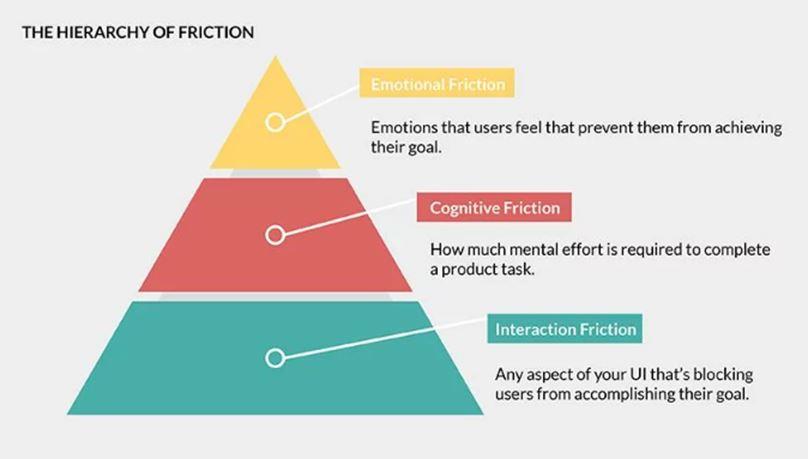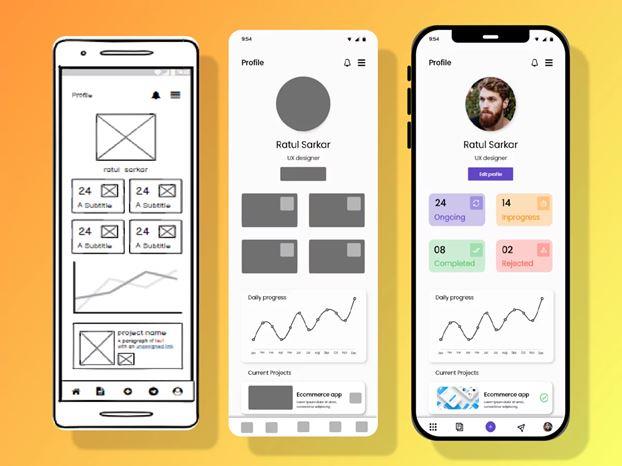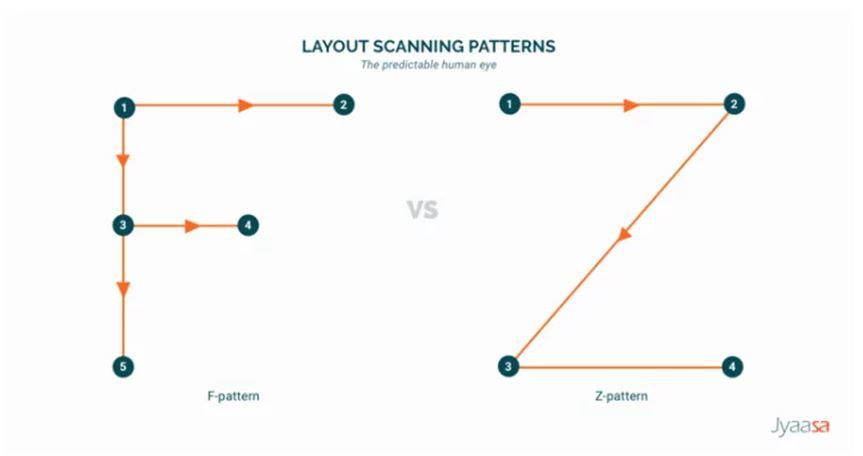Have an idea for a mobile app but don’t know where to start?
Don’t worry; we have got you covered. Before talking about your app idea to your business bud or partner, you need to educate yourself on the vast topic of designing mobile apps. Whether you want a mobile app for your decade-old business, startup, or organization- the first step will always be- research.
Through this blog, you will discover the following:
- What is UI and UX design?
- What is UI UX mobile app design?
- Steps to design a mobile app.
Without any further ado, let us begin.
What is UI Design?
UI stands for “user interface.” User interface (UI) is a design process to create engaging interfaces via a computerized software device. Mobile app UI design is needful to ensure that each user experiences an app or device as interesting.
UI for users comes in three formats:
- Graphical user interfaces (GUIs): An individual interacts with visual representation via a computer desktop or digital control panels.
- Voice-controlled interfaces (VUIs): Smart assistants like Siri and Alexa are VUIs.
- Gesture-based interfaces: Under this, user engages with 3D design spaces via bodily motions.
What is UX Design?
UX stands for “user experience.” User experience is a design strategy that focuses on enhancing users’ needs. UX specialists’ primary goal is to ensure a mobile app meets user expectations and offers users value. The vital pillars of a successful UX design are good usability, accessibility, usefulness, and dependability.
UX for users comes in three formats:
- Interaction design,
- Visual design, and
- Information architecture.
What is App Design?
App design comprises user experience (UX) and user interface (UI) elements. The app design process includes ideation, defining solutions, and creating the app’s flow and structure. A designer also has to make stylistic choices from colors to app fonts.
Crucial Steps to Mobile App Design
- Conduct Market Research
Market research is undoubtedly the first step toward creating a great app. You can determine what trends are popular among most users with in-depth research. You need to explore the variety of apps available on Play Stores and analyze which apps are performing well.
You may want an app with many features and bold colors, but your target users may prefer elegant products with minimalistic features and functionality. At the end of the day, you want to meet your users’ expectations- understanding your users’ app requirements must be a top priority.
Below are some vital market research techniques to try:
- Competitor research
Researching your prime competitors gives you the upper hand and insights into other businesses’ performance. Smart companies invest a lot of time and money researching their competitor’s strategies.
- Customer segmentation research
Satisfying every user is impossible; users have different tastes, preferences, and traits. Customer segmentation research helps you identify your target audience. This method divides the target audience into smaller groups based on gender, age, behavior, etc.
- Product development
This method is super-important; you can save money and valuable time before beginning the app development process. Product research helps you determine your mobile app concept; take advantage of this crucial market research approach.
- Usability testing
Usability testing directs focus on the usability of a product. Through the help of this research method, you can know how users interact with various aspects of your application. You will need to conduct platform-specific research (for Android and iOS). Android design guidelines vary from an iOS app.
- Set Your App’s Goal
Before you begin the initial steps of app designing, think about what you want to accomplish with the app. We need you to put on your thinking cap and jot down answers to the below-mentioned questions:
- What does your app do exactly?
- What is your app’s goal?
- How will you present your app to users?
- What pain point do you want to address via your app?
- Why should people use your app?
- What makes your app unique?
Mobile App Design Process
After covering the basics comes the following procedure of mobile app designing.
- Create a user-flow diagram
- Create the Low-Fidelity Wireframe
- Crafting the high-fidelity wireframe
- Develop the User Interface
- Decide on your Product Specifications
- Pass on the Design to Developers
- Create a user-flow diagram
A user-flow diagram represents a user’s journey through your mobile app. In short, user flow is how users move from one screen to another to accomplish any task in your app. Here is an example of food ordering app user flow:
- A user logs in to the app
- It then shows list of available restaurants in specific area
- User pick the restaurant they want to order from and it will show the menu
- They then select the items from menu and add them to cart
- Finally, he/she checks out, put in delivery information and pays for the order.
User flow is essential to optimize an app’s UX. With the help of a mobile app UX, you can easily visualize the steps for every task and feature. Following a user flow allows you to plan the screens and assets you require to design, saving you valuable time.
Using a user flow diagram, you can uncover any issues that may occur with your app flow and lead to friction. Friction is any obstacle that hampers the user experience. It surfaces at three different levels:

PC: Decode
Another advantage to applying user flow is that they are excellent at detecting and fixing friction issues at every level possible. For example, the most common UX issue is unnecessary steps in between points A to B. Such inconvenience causes interaction friction, hindering users from completing a task effortlessly.
Other frictions that can happen are cognitive and emotional; both are frustrating- all this can be avoided with the use of planned user flow. You aim to offer an effortless app experience to your target audience. And a user flow is a potent part of that.
It would be helpful if you refine your user flow if things do not go as planned. Thus, take as much time as you need to create a solid app flow diagram. And do not expect to get it right on the first attempt; it can go as far as ten attempts.
- Create the Low-Fidelity Wireframe
The next step in designing the mobile app is to start working on the wireframes.
What is a wireframe?
Wireframes are blueprints of your mobile app’s architecture. Wireframes help you visualize your app’s basic flow from one screen to another. In short, rough draft of how your app will function. It is recommended and best to start with UX (user experience) and wireframes before shifting to the appearance and feel of an app.
A wireframe must include the following:
- Page Layout Designs
- App Layout Designs
- Navigation Elements
Start with crafting a low-fidelity wireframe. Think of a low-fidelity wireframe as a rough paper; you lay down the content, basic layout, and purpose of each screen in your app. The prime purpose of investing in a low-fidelity wireframe is to envision your app and see how it will appear so that you can ask for audience/people feedback. While working on a wireframe, you can spot issues that can later bother your design process. Once approved, a low-fidelity wireframe can work as the foundation of your final app design.
Low-fidelity wireframes work as a charm; consider them your best friend, guiding you every step of the process. They include wireframes composed of simple shapes representing UI elements and content. Remember, you want to develop a wireframe swiftly to revise and optimize your mobile app design.
Crafting the high-fidelity wireframe
After you have your low-fidelity wireframe ready and are happy with it, the next step will be to turn it into a high-fidelity wireframe.
A high-fidelity wireframe is the polished version of your app architecture. It must contain elements close to the final mobile app’s design, such as graphics, images, icons, color schemes, and content. The potent goal here is to evaluate your app’s every UX issue and fix nuances in the layout.
High-fidelity is the best option if you are responsible for showcasing your design to external stakeholders who want to see the app’s layout. To give you an idea, here are depictions of a sketch of low-fidelity and high-fidelity wireframes:

PC: Dribble
Develop the User Interface
After you have approval on your app’s wireframes, it’s time to create the “actual” app design. In this phase, you must decide on vital design aspects such as color, layout, icons, illustrations, notification sounds, and images. This is the exciting phase where you can include the assets in your final app design.
Shape patterns are taken into account in this phase as well. The main idea behind this is to place key elements on fixation points so users can instantly become aware of them. There are two patterns:
- the F-shape, and
- Z-shape.
The F-shape is used in case of UI layouts that include large text blocks. The Z-shape on the other hand, is ideal for UI screens.

Another powerful interface to tackle is the two-handed operations. As most people use smartphones, the two-handed operation is undoubtedly significant. To be, you need to watch out for the thumb zone, which is the ordinary area users can effortlessly reach with their thumb. Key elements such as navigation should be within the thumb’s reach. You must figure out a common ground that fits best for all users.
Here is a reference:

- Decide on your product specifications
Before you pass the UI design to developers, you must come up with your product specifications. Product specifications play the role of a guide that communicates with the developer and provides them with the design assets’ exact requirements. In short, developing these guidelines will help developers implement your produced mobile app design.
Important information to include in product specifications are:
- Dimensions,
- File format,
- Color hex code, and
- Font names.
You also need product specifications to showcase the different stages of your UI component. You will be surprised to know, but it may not be apparent when looking at your design or wireframe. Button states are an excellent example of product specifications. A well-crafted product specification guide should be able to tell how a button appears when they are active, pressed, or disabled. You can use tools such as Zeplin to generate particular product features.
- Pass on the Design to Developers
After your product specifications are ready, you have everything to submit to developers. A successful hand-off is essential to ensure a smooth app process further. We recommend communicating openly with the developers and telling them your vision.
A Mobile App Design Final Three Steps
- Testing,
- Feedback, and
- Iteration
Once you are done with the above steps, you can finally start testing your mobile app for usability and ask for feedback. To receive feedback, you should create a user or consumer feedback loop to remain aware of every insight—and once you are given feedback, implement it by redesigning and updating your app.
How to create feedback loops?
Creating a feedback loop is simple. Here is an example:

PC: convas.io
Plus, you must give your users plenty of choices to provide ratings and reviews. This can include the following:
- App Store Profile
- Social Media Profiles
- GMB (Google My Business) Page
- Website
You can also go for the below-mentioned app design testing which includes:
- Focus Groups
- Usability Tests
- QA Testing
- A/B Testing
Ask everyone to test the app, your friends, colleagues, and family. The more people use your mobile app, the better feedback. Think of the app design testing phase as “always beta.”
Have an App Idea in Mind?
Good design is imperative to create a compelling and engaging mobile application. After reading this blog, we hope you have gained a deep insight into how to design an app. App designing is a creative and challenging process. To pull that off, you need assistance from a professional design agency.
If you want to have a skilled agency by your side, start searching for an experienced UI UX design agency. Ensure to see their website and portfolio section to get an idea of their past projects.
Prabhjot Singh
Creative Content Executive at UIUXDen
Mississauga, Ontario, Canada
He enjoys writing about current design trends and new technologies. His ability to blend words to convey the most information in the fewest possible words enables him to produce impactful, relevant, practical content for all kinds of readers.